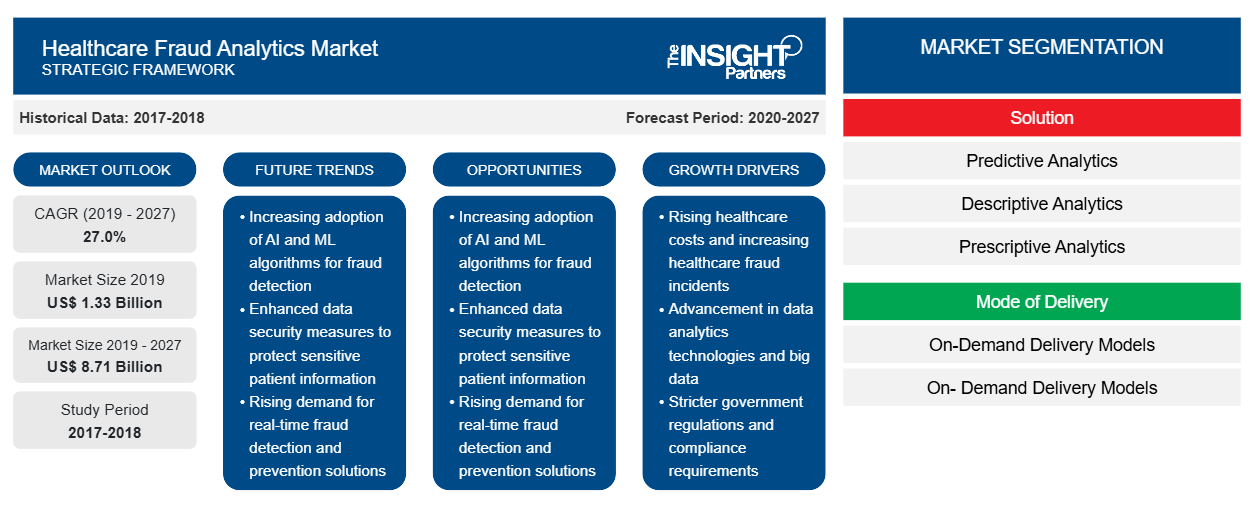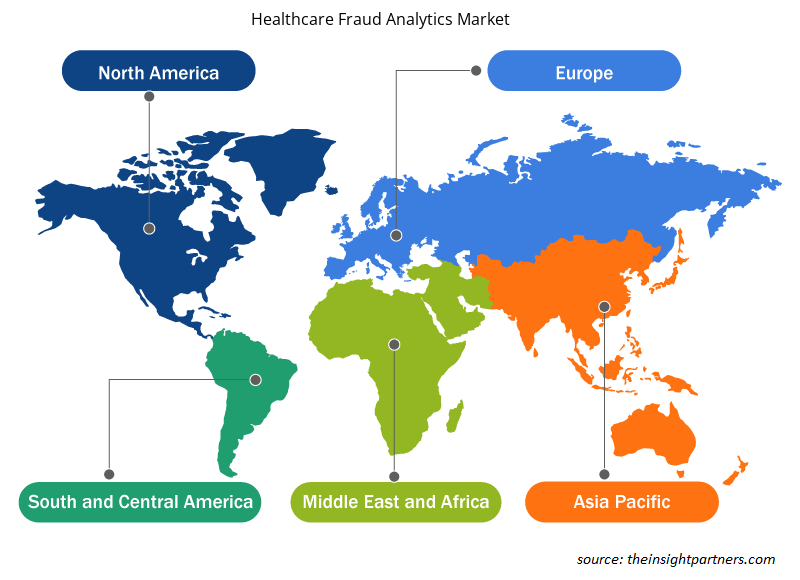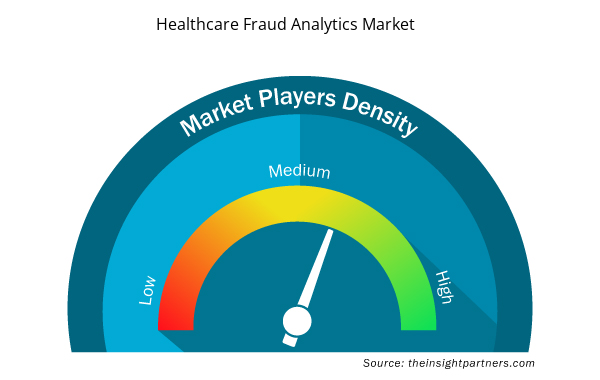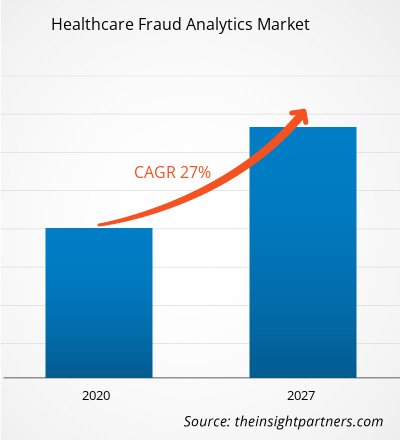The healthcare fraud analytics market was valued at US$ 1,331.09 million in 2019 and it is projected to reach US$ 8,707.73 million in 2027; it is expected to grow at a CAGR of 27.0% from 2020 to 2027.
Healthcare fraud is a kind of white-collar crime that includes the filing of dishonest health care claims to turn a profit. The majority of health care fraud is committed by organized crime groups and a small minority of fraudulent health care providers. The most common types of health care fraud include billing for more expensive services or procedures, misrepresenting non-covered treatments, insurance frauds, and others. The growth of the global healthcare fraud analytics market is attributed to the increasing number of fraud cases across all industries, and growing health insurance industry in the US. However, concerns regarding healthcare fraud analytics is the major factor hindering the market growth.
The global healthcare fraud analytics market is expected to witness substantial growth post-pandemic. The COVID-19 has affected economies and industries in various countries due to lockdowns, travel bans, and business shutdowns. The COVID-19 crisis has overburdened public health systems in many countries and highlighted the strong need for sustainable investment in health systems. As the COVID-19 pandemic progresses, the healthcare industry is expected to see a drop in growth. The life sciences segment thrives due to increased demand for invitro diagnostic products and rising research and development activities worldwide. However, the medical technologies and imaging segment is witnessing drop in sales due to a smaller number of surgeries being carried out and delayed or prolonged equipment procurement. Additionally, virtual consultations by healthcare professionals are expected to become the mainstream care delivery model post-pandemic. With telehealth transforming care delivery, digital health will continue to thrive in coming years. In addition, disrupted clinical trials and the subsequent delay in drug launches is also expected to pave the way for entirely virtual trials in the future. New technologies such as mRNA is expected to emerge and shift the pharmaceutical industry and market is also expected to witness more vertical integration and joint ventures in coming years.
Customize This Report To Suit Your Requirement
You will get customization on any report - free of charge - including parts of this report, or country-level analysis, Excel Data pack, as well as avail great offers and discounts for start-ups & universities
Healthcare Fraud Analytics Market: Strategic Insights

- Get Top Key Market Trends of this report.This FREE sample will include data analysis, ranging from market trends to estimates and forecasts.
You will get customization on any report - free of charge - including parts of this report, or country-level analysis, Excel Data pack, as well as avail great offers and discounts for start-ups & universities
Healthcare Fraud Analytics Market: Strategic Insights

- Get Top Key Market Trends of this report.This FREE sample will include data analysis, ranging from market trends to estimates and forecasts.
Market Insights
Growing Health Insurance Industry in the US to Drive Global Healthcare Fraud Analytics Market Growth
Health insurance fraud is a deliberate deception committed against an insurance company or agent to achieve financial gain. Frauds are committed at different transaction points by the applicants, policyholders, third-party claimants, or healthcare professionals who offer services to claimants. Sometimes insurance agents, as well as company employees, may also commit insurance fraud. Common health insurance frauds include padding that is manipulating the legitimate claims, exaggerating the facts on an insurance application, submitting claims for diseases or injuries that never occurred, and staging accidents.
In the United States, there are more than 900 health insurance companies that offer medical coverage. Moreover, the number of people with health insurance coverage in the United States is high. As per the report Health Insurance Coverage in the United States: 2018, in the year 2018, approximately 91.5% of the population has health insurance. The report also mentioned that, in 2018, private health insurance coverage was more prevalent in the US than public coverage, about 67.3% of the population had private health insurance coverage and 34.4% had public coverage. Among the subtypes, employer-based insurance was the most common health insurance coverage accounting for 55.1 % of the population.
Owing to the growing health insurance industry and the rising number of health insurance frauds, the demand for healthcare fraud analytics solutions is expected to increase during the forecast period.
Solution - Based Insights
In terms of solution, the global healthcare fraud analytics market is segmented into predictive analytics, descriptive analytics, and prescriptive analytics. In 2019, the predictive analytics segment held largest share of the market. Moreover, the same segment is estimated to register the highest CAGR during the forecast period.
Mode of Delivery-Based Insights
Based on mode of delivery, the global healthcare fraud analytics market is segmented into on-premise delivery models, and cloud-based delivery models. The on-premise delivery models segment held the largest market share in 2019. However, cloud based delivery models segment is estimated to register the highest CAGR during the forecast period.
Application-Based Insights
Based on application, the global healthcare fraud analytics market is segmented into insurance claims review, pharmacy billing misuse, payment integrity, medical identity theft and other applications. The insurance claims segment held the largest market share in 2019. Also, the same segment is estimated to register the highest CAGR during the forecast period.
End User-Based Insights
In terms of end user, the global healthcare fraud analytics market is segmented into government agencies, private insurance payers, third-party service providers, and employers. The government agencies segment held the largest share of the market in 2019, and the same segment is estimated to register the highest CAGR during the forecast period.
The global healthcare fraud analytics market players are adopting the product launch and expansion strategies to cater to changing customer demands worldwide, which also allows them to maintain their brand name globally.
Healthcare Fraud Analytics Market Regional Insights
The regional trends and factors influencing the Healthcare Fraud Analytics Market throughout the forecast period have been thoroughly explained by the analysts at Insight Partners. This section also discusses Healthcare Fraud Analytics Market segments and geography across North America, Europe, Asia Pacific, Middle East and Africa, and South and Central America.

- Get the Regional Specific Data for Healthcare Fraud Analytics Market
Healthcare Fraud Analytics Market Report Scope
| Report Attribute | Details |
|---|---|
| Market size in 2019 | US$ 1.33 Billion |
| Market Size by 2027 | US$ 8.71 Billion |
| Global CAGR (2019 - 2027) | 27.0% |
| Historical Data | 2017-2018 |
| Forecast period | 2020-2027 |
| Segments Covered |
By Solution
|
| Regions and Countries Covered | North America
|
| Market leaders and key company profiles |
Healthcare Fraud Analytics Market Players Density: Understanding Its Impact on Business Dynamics
The Healthcare Fraud Analytics Market is growing rapidly, driven by increasing end-user demand due to factors such as evolving consumer preferences, technological advancements, and greater awareness of the product's benefits. As demand rises, businesses are expanding their offerings, innovating to meet consumer needs, and capitalizing on emerging trends, which further fuels market growth.
Market players density refers to the distribution of firms or companies operating within a particular market or industry. It indicates how many competitors (market players) are present in a given market space relative to its size or total market value.
Major Companies operating in the Healthcare Fraud Analytics Market are:
- Conduent Inc.
- DXC Technology
- Scioinspire, Corp.
- FICO
- Optum, Inc.
Disclaimer: The companies listed above are not ranked in any particular order.

- Get the Healthcare Fraud Analytics Market top key players overview
Global Healthcare Fraud Analytics Market – by Solution
- Predictive Analytics
- Descriptive Analytics
- Prescriptive Analytics
Global Healthcare Fraud Analytics Market – by Mode of Delivery
- On-Premise Delivery Models
- Cloud Based Delivery Models
Global Healthcare Fraud Analytics Market – by Application
- Insurance Claims Review
- Pharmacy Billing Misuse
- Payment Integrity
- Medical Identity Theft
- Other Applications
Global Healthcare Fraud Analytics Market – by End- User
- Government Agencies
- Private Insurance Payers
- Third-party Service Providers
- Employers
Global Healthcare Fraud Analytics Market – by Geography
North America
- US
- Canada
- Mexico
Europe
- France
- Germany
- Italy
- UK
- Spain
- Rest of Europe
Asia Pacific (APAC)
- China
- India
- South Korea
- Japan
- Australia
- Rest of APAC
Middle East & Africa (MEA)
- South Africa
- Saudi Arabia
- UAE
- Rest of MEA
South America and Central America (SCAM)
- Brazil
- Argentina
- Rest of SCAM
Company Profiles
- Conduent Inc.
- DXC Technology
- Scioinspire, Corp.
- Optum, Inc.
- SAS Institute
- Pondera Solutions
- Lexisnexis Risk Solutions
- Fair, Isaac and Company(FICO)
- Cotiviti, Inc.
- Whitehatai
- Historical Analysis (2 Years), Base Year, Forecast (7 Years) with CAGR
- PEST and SWOT Analysis
- Market Size Value / Volume - Global, Regional, Country
- Industry and Competitive Landscape
- Excel Dataset


- Single-Use Negative Pressure Wound Therapy Devices Market
- Semiconductor Metrology and Inspection Market
- Carbon Fiber Market
- Arterial Blood Gas Kits Market
- Hydrolyzed Collagen Market
- Underwater Connector Market
- Virtual Event Software Market
- Online Exam Proctoring Market
- Architecture Software Market
- Smart Mining Market

Report Coverage
Revenue forecast, Company Analysis, Industry landscape, Growth factors, and Trends

Segment Covered
Solution ; Mode of Delivery ; Application ; End User and Geography.

Regional Scope
North America, Europe, Asia Pacific, Middle East & Africa, South & Central America

Country Scope
Argentina, Australia, Brazil, Canada, China, France, Germany, India, Italy, Japan, Mexico, RoMEA, RoSCAM, Saudi Arabia, South Africa, South Korea, Spain, United Arab Emirates, United Kingdom, United States
Frequently Asked Questions
What is the average cost of healthcare fraud to the total healthcare expenditure?
As per the Global Health Care Anti-Fraud Network, each year approximately US$ 260 billion (180 billion euros) or about 6 percent of the global total health care expenditure is lost to fraud. The number of healthcare frauds is increasing in the US. Some government and law enforcement agencies also estimated that healthcare frauds cost around 10% of the total annual health expenditure, which could be around US $300 billion.
What is Healthcare fraud?
Healthcare fraud is a kind of white-collar crime that includes the filing of dishonest health care claims to turn a profit. The majority of health care fraud is committed by organized crime groups and a small minority of fraudulent health care providers. The most common types of health care fraud include billing for more expensive services or procedures, misrepresenting non-covered treatments, insurance frauds, and others.
What are the driving factors for the healthcare fraud analytics market across the globe?
factors such as rising number of healthcare fraudulent cases across the globe and growing health insurance industry are expected to boost the market growth over the years. Moreover, growing hospital industry is likely to have a positive impact on the growth of the market in coming years.
Trends and growth analysis reports related to Technology, Media and Telecommunications : READ MORE..
The List of Companies – Global Healthcare Fraud Analytics Market
- Conduent Inc.
- DXC Technology
- Scioinspire, Corp.
- FICO
- Optum, Inc.
- SAS Institute
- Pondera Solutions
- Lexisnexis Risk Solutions
- Whitehatai
- Cotiviti, Inc.

 Get Free Sample For
Get Free Sample For